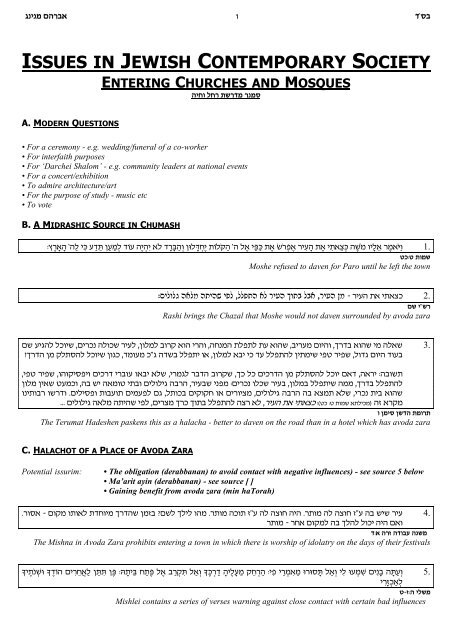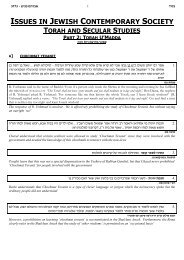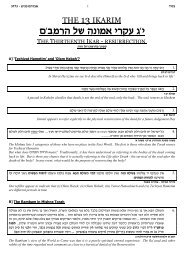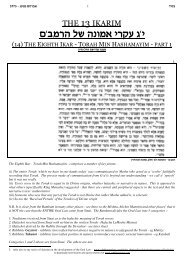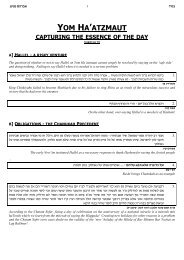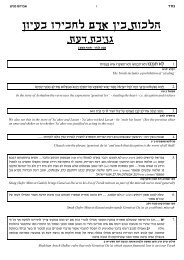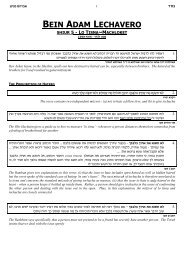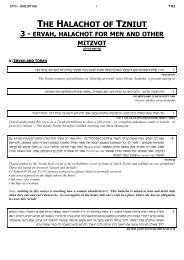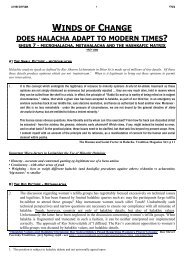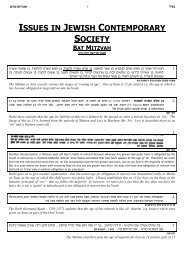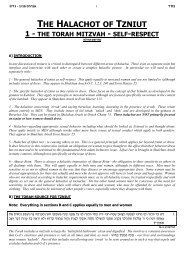Entering into Churches and Mosq - Rabbi Anthony Manning
Entering into Churches and Mosq - Rabbi Anthony Manning
Entering into Churches and Mosq - Rabbi Anthony Manning
Create successful ePaper yourself
Turn your PDF publications into a flip-book with our unique Google optimized e-Paper software.
dbhbn ovrct<br />
ISSUES IN JEWISH CONTEMPORARY SOCIETY<br />
A. MODERN QUESTIONS<br />
ENTERING CHURCHES AND MOSQUES<br />
vhju kjr ,arsn rbnx<br />
• For a ceremony - e.g. wedding/funeral of a co-worker<br />
• For interfaith purposes<br />
• For ‘Darchei Shalom’ - e.g. community leaders at national events<br />
• For a concert/exhibition<br />
• To admire architecture/art<br />
• For the purpose of study - music etc<br />
• To vote<br />
B. A MIDRASHIC SOURCE IN CHUMASH<br />
1<br />
:.¤r¨t¨v �v�k h�F g©s¥T i�g©n�k sIg v®h§v°h tO s¨r�C©v±u iUk¨S§j®h ,Ik«E©v �v k¤t h�P�F ,¤t G«r�p¤t rh�g¨v ,¤t h¦,t�m�F v¤J«n uh�k¥t r¤nt«H³u 1.<br />
yf:y ,una<br />
Moshe refused to daven for Paro until he left the town<br />
s�xc<br />
:ohkukd vtkn v,hva hpk 'kkp,v tk rhgv lu,c kct 'rhgv in - rhgv ,t h,tmf 2.<br />
oa h"ar<br />
Rashi brings the Chazal that Moshe would not daven surrounded by avoda zara<br />
oa ghdvk kfuha 'ohrfb vkufa rhgk 'iuknk cure tuv hrvu 'vjbnv ,kp,k ,g tuva 'chrgn ouhvu 'lrsc tuva hn vkta<br />
?lrsv in ek,xvk kfuha iudf 'snugn f"d vsac kkp,h ut 'iuknk tch hf sg kkp,vk ih,nha hpy rhpa 'kusd ouhv sugc<br />
'hpy rhpa 'uvuehxphu ohfrs hrcug utch tka 'hrndk rcsv curea 'lf kf ohfrsv in ek,xvk kfuh ots 'vtrh :vcua,<br />
iukn ihta ygnfu 'vc ah vtnuy h,cu ohkukhd vcrv 'rhgca hbpn :ohrfb ukfa rhgc 'iuknc kkp,ha vnn 'lrsc kkp,vk<br />
ubh,ucr uarsu /ohkhxpu ,ucgu, ohngpk od 'k,ufc oheuej ut ohruhmn 'ohkukhd vcrv vc tmn, tka 'hrfb ,hc tuva<br />
/// ohkukhd vtkn v,hva hpk 'ohrmn lrf lu,c kkp,vk vmr tk 'rhgv<br />
,t h,tmf : (yf :y ,una t,khfn) vz tren<br />
u inhx iasv ,nur,<br />
The Terumat Hadeshen paskens this as a halacha - better to daven on the road than in a hotel which has avoda zara<br />
C. HALACHOT OF A PLACE OF AVODA ZARA<br />
Potential issurim: • The obligation (derabbanan) to avoid contact with negative influences) - see source 5 below<br />
• Ma’arit ayin (derabbanan) - see source [ ]<br />
• Gaining benefit from avoda zara (min haTorah)<br />
/ruxt - ouen u,utk ,sjuhn lrsva inzc ?oak lkhk uvn /r,un vfu, z"g vk vmuj vhv /r,un vk vmuj z"g vc aha rhg 4.<br />
r,un - rjt ouenk vc lkvk kufh vhv otu<br />
s:t vrz vsucg vban<br />
The Mishna in Avoda Zara prohibits entering a town in which there is worship of idolatry on the days of their festivals<br />
Wh¤,«b§JU W¤sIv oh¦r¥j£t�k i¥T¦T i�P :V¨,h�C j©,�P k¤t c©r§e¦T k©t±u W�F§r©s ¨vh�k�g¥n e¥j§r©v :h�p h¥r§n¦t¥n UrUx¨T k©t±u h�k Ug§n¦J oh°b�c v¨T�g±u 5.<br />
h¦r²z�f©t�k<br />
y-z:v hkan<br />
Mishlei contains a series of verses warning against close contact with certain bad influences<br />
3.
dbhbn ovrct<br />
kt cre, kt ;tu ',ubhnnu d"gv hfrsn ejr,a k"r vmhknv hpku 'oa vbbht vbuzva ;t v,hc j,p kt cre, kt //// 6.<br />
vru,k intb ,hc oc ,ubck vktv ohaehvc an,a, v,ta rnt, tku 'vrhpfv hrga kt ohxbfb oca ohaehvu ,ugmvv<br />
vsug,ku<br />
oa o"hckn<br />
The obvious pshat in the pesukim refers to associating with places of immorality but the deeper meaning refers also to<br />
avoiding close connections with a places of avoda zara, even for purposes other than worship e.g. entertainment<br />
2<br />
s�xc<br />
,unt gcrt :tsxj cr rnt ?vnfu ///// ,ubhn uz - lfrs vhkgn ejrv (�v hkan) 7.<br />
/zh vrz vsucg<br />
The gemara rules that a person must always remains at least 4 amot from a place of avoda zara<br />
/,ubuz hcs tj,hpt hmp sju 'ohcfuf ,sucgs tj,hpt hmp sj 'hkhca hr, uvbvk uyn 'tjrutc hkzte uuv i,buh wru tbhbj wr 8.<br />
'ihrmhk vhhpfbu ,ubuz hcs tj,hpt khzhb :lsht k"t 'vhrmh xhfbs ohcfuf ,sucgs tj,hpt khzhb :vhrcjk sj vhk rnt<br />
vhhnen ugbf,ht ',ubuzk uvbhzj o,v uyn hf /trdt kcebu<br />
/zh vrz vsucg<br />
The Gemara records a discussion between two sages about whether it was better to walk by a place of idolatry or a place<br />
of immorality. They decided to walk past the brothel rather than go near the place of idolatry<br />
,unt ws ohcfuf ,sucg lrsn ejr,vk vumn 9.<br />
t ;hgx be inhx ohcfuf ,sucg ,ufkv vgs vruh lurg ijkua<br />
The Shulchan Aruch rules that one must stay 4 amot away from avoda zara<br />
ivhshc ivh,uct dvbn tkt 'iv ohcfuf ,sucg hscug utk .rtk vmujca ohrfb :ibjuh r"t tct rc thhj wr rnts 10.<br />
:dh ihkuj<br />
However, even in talmudic times, there was an awareness that many of the non-Jews of the time were not real idolators<br />
D. WHAT IS AVODA ZARA?<br />
t²B©e k¥t WheO¡t �v h�f«b¨t h�F //// :h²b�P k�g oh¦r¥j£t oh¦vO¡t W�k v®h§v°h tO oh¦s�c�g ,h�C¦n o°h©r�m¦n .¤r¤t¥n Wh¦,t�mIv r¤J£t WheO¡t �v h�f«b¨t 11.<br />
///<br />
s-c:f ,una<br />
Idolatry comes in different forms - the classic form is the rejection of Hashem for another god<br />
Ij�c°Z¦n ¨T�k�f¨t±u W�k t¨rë±u o¤vh¥vOt�k Uj�c²z±u o¤vh¥vO¡t h¥r£j©t Ub²z±u .¤r¨t¨v c¥JIh�k ,h¦r�C ,«r�f¦T i�P 12.<br />
uy:sk ,una<br />
In this vein, avoda zara is compared with a ‘znut’ - sexual infidelity<br />
k¤x�P o�f�k o¤,h¦G�g³u iU,¦j§J©T i�P :J¥t¨v QIT¦n c¥r«j�C o�fh�k£t �v r�C¦S oIh�C v²bUn§T k�F o¤,h¦t§r tO h�F o�fh¥,«J�p³b�k s«t§n o¤T§r©n§J°b±u 13.<br />
v�c¥e±b It r�f²z ,h°b�c©T k¤n¨x k�F ,³bUn§T<br />
zy-uy:s ohrcs<br />
However, avoda zara is also a form of corruption of true worship of Hashem eg serving Hashem through some<br />
intermediary<br />
E. IS CHRISTIANITY AVODA ZARA?<br />
wt ouh :ktuna rnt hnhsct rc tphkj, cr rnts 'a", ///// `ruxt ivhrjtk vakau ovhbpk vaka :rnut ktgnah wr 'a", 14.<br />
ruxt okugk ktgnah hcr hrcsk<br />
ubka txrhd /u vrz vsucg<br />
The Talmud prohibits doing business with idolators on their festival days. R. Yishmael’s view is that even 3 days before<br />
or 3 days after is prohibited <strong>and</strong> that ‘Sunday’ is always prohibited
dbhbn ovrct<br />
ruxt okugk ktgnah hcr hrcsk hrmub ouh :ktuna rnt hnhsct rc tphkj, cr rnts 'a", 15.<br />
hruen txrd - /u vrz vsucg<br />
In fact, the original text of the Talmud does not read ‘Sunday’ but ‘the Christian [notzri] day’ This was censored (or<br />
self-censored) out of the Talmud<br />
,cac �tc sht ouh ,uagk ovk vuma ahtv u,t ka ,ugyc lkuvv - hrmub 16.<br />
(ubka x�ac ghpun tk) hruen txrd - /u vrz vsucg �har<br />
The original text of Rashi (also now censored) explains that Sunday was decreed as the Christian Sabbath by ‘that man’.<br />
Note that most talmudic references to early Christianity are to a deviant Jewish heresy - minut - not a separate religion<br />
(a) The View of the Rambam<br />
(jpte crv oudr,) t vban t erp vrz vsucg ,fxn o"cnrk vbanv aurhp<br />
The Rambam’s view is clear - Christianity is avoda zara, Christians are idolators <strong>and</strong> Sunday is an idolatrous festival!<br />
ohrmbv kct,<br />
ohbutdv kf uruv ifu vhhbvc r,unu vhh,ac ruxt ibhh ohktgnahv ukt iudf z"<br />
g scug ubhta hud kf ifu ..... 18.<br />
. vhhbvc ruxt obhh o,xu iv z"<br />
g hscug<br />
z vfkv th erp ,uruxt ,ukftn ,ufkv o"cnr<br />
The Rambam (in the uncensored version) clearly rules that Christians are idolators <strong>and</strong> their wine is prohibited even to<br />
derive benefit from<br />
(b) The View of the Tosafot<br />
By the time of the Ba’alei Tosafot, Jews in Northern Europe were in business relationships with non-Jewish Christians in<br />
a number of areas, including:- business on Sundays (market day), partnerships with non-Jews, dealing in Christian ritual<br />
objects<br />
hra tngy htvnu ohcfuf ,sucgk ujkp tks uvhhudc ik ohe ubhbhca o"ufgs ouan r,hvv ogys vtrb lfk //// 19.<br />
/c vrz vsucg ,upxu,<br />
Here Tosafot avoids the potential halachic problems by leaving the classification of Christianity as A.Z. but reclassifying<br />
most Christians as non-believers <strong>and</strong> thus not idolators<br />
vna p"gtu ,uvkt ovc ihxpu, ihtu ivka ohasec ohgcab ikuf vzv inzc n"n ///// - ,up,ua vagha ostk ruxt 20.<br />
oa ihp,ana p"gtu ohna vaugk o,gs od ohcfuf ,sucg oa vz iht n"n rjt rcsk o,buufu a"a ovng ihrhfzna<br />
lf kg urvzuv tk jb hbcs tfhk rug hbpku ;,ak ohrjtk ourdk ruxts ijfat tk rjt rcsu ohna<br />
:dx ihrsvbx ,upxu,<br />
This Tosafot deals with being in business partnership with Christians, a halachic problem due to the possibility of<br />
causing the non-Jewish partner to take an oath in the name of his god. Tosafot goes one stage further than in source 19.<br />
Here there is a redefinition of Christianity itself. For a non-Jew to take an oath in the name of a Christian saint is<br />
acceptable as the saint has no divinity. Further, when they mention ‘God’, they are referring to the same G-d as we do.<br />
3<br />
s�xc<br />
17.
dbhbn ovrct<br />
Also, the connection of G-d’s name with another being in a religious context is not prohibited for non-Jews. On a simple<br />
reading, this refers to connecting God <strong>and</strong> the saint - c.f. "Cry ‘God for Harry, Engl<strong>and</strong>, <strong>and</strong> Saint George!’ " (Henry V:<br />
Act III, Scene I). However, many poskim have seem this Tosafot as referring to the Christian joining of the concept of G-d<br />
<strong>and</strong> another being /medium to G-d eg Jesus<br />
Tosafot has thus apparently established that practical business interaction with non-Jews is allowed since (a)<br />
Christianity is avoda zara for Jews but not for non-Jews; <strong>and</strong> (b) many Christians are not really believers anyway<br />
,tak r,un lfhpk ohcfuf ,sucg hscug obht vzv inzc kct 'inz u,utc tkt ohrunt ukt ohrcs kf ihta ohrnut ah 21.<br />
ohrcs rta kfu o,uukvku odj ouhc ovng ,,ku<br />
ch:jne inhx ohcfuf ,sucg ,ufkv vgs vruh lurg ijkua<br />
The Shulchan Aruch brings the view of Tosafot as a ‘Yesh Omrim’ which generally means a secondary opinion not to be<br />
relied upon lechatchlia<br />
'rjt ouenc ,ubek ukfuh tka ut uc tmuhf ohrjt ovk iht ot teus ubhhv 'o,sucgk ohfhhav ohrcs ovk rufnk ruxts tv t"h 22.<br />
rhnjh apb kgc kfu 'vbuatrv trcxf kevk udvbu /ihrhnjn ahu /rcs kf ovk rufnk r,un 'rjt ouenc ,ubek ohkufh ot kct<br />
unmgk<br />
t:tbe inhx ohcfuf ,sucg ,ufkv vgs vruh lurg ijkua<br />
The Rema in Shulchan Aruch rules that Jews are permitted to sell Christian religious objects<br />
n"n 'z"gv ihrhfzns d"gtu 't"gc ohgcab vzv inzc oh,ufv ihta ouan 'z"vnzc oh,ufv og ,up,ua ,hhagc ihkhen ahu 23.<br />
obht hrvs kuafn i,, tk rug hbpku :ouan vzc aha ubhmn tku 't"su ohna oa ohp,ana tkt .rtu ohna vaugk o,buuf<br />
hra g"fk ',up,ua tkc ovng ,,ku ,taku `(urufcs e"p ahr wxu,u v"j z"hb ojurh wru z"gs e"px i"r) ;u,av kg ihrvzun<br />
(z"g ,ufkvn e"p hbunhhn ,uvdv) ovhdj ouh tkc<br />
ube inhx ,xbfv ,hc ,ufkv ohhj jrut lurg ijkua<br />
The Rema here explicitly underst<strong>and</strong>s that Christians today are technically not involved in Avoda Zara since they are not<br />
prohibited in ‘shituf’ - the Trinity<br />
tku rjt rcsu ohna oa ohp,ana tkt .rtu ohna vaugk o,buufa ovng ;,,avk r,un vzv inzcs ///// - kevk udvbu 24.<br />
;u,av kg ihrvzun jb hbc ihta rug hbpk ouan vzc aha ubhmn<br />
tbe inhx vgs vruh l"a<br />
The Shach brings the wording of Tosafot - that non-Jews are allowed to engage in ‘shituf’. Causing them to make an oath<br />
is not therfore prohibited<br />
However, there is some considerable debate as to how to underst<strong>and</strong> the position of Tosafot!<br />
wuf ohcfuf ,sucgc ihgcab obhta ouan ohcfuf scugv og ,up,uac ihkhen ahu vvdvc c,f oas - u"be whx j"tc (c) 25.<br />
vsuvhc gsub ,cua,c whgu ;u,hav kg ohrvzun obht hrvs g"pk ouan vzc aha ubhmn tku rjt rcsu a"a ohp,an tkt<br />
tuv ;u,hav kg ohuumn ohcfuf hscugv ihta habhts uvhhnupc tkdrns vn jhfuvk lhrtva (j"ne whx ;ux s"uh ekj tbhhb, )<br />
urhfzna er v,t hkt rnut ubhta vgucac ;,ana vns t"nrv ,buuf ,ntcu k"bv t"nrv iuakn vz ovk tmhu ,ugy<br />
scugaf kct /z"g ohrvzun iht ohcfuf hscug kct ugca, unacu ch,fs ktrahk ruxht ubhmn vzc a"a og u,gucac<br />
f"fu a"g f"f inhx vesm khgn ,cua,c f"fu /a"g ohcfuf scugk ktrah ihc kkf eukhj iht ;u,hac ohcfuf ,sucg<br />
if rnuk rapt ht n"n tuv if ,ntva ;t s"gku /(a"g v"n e"x ;ux s"pac v"x inhx khgk) d"npc h,tmn ifu ohrpt rga ,cua,c<br />
lphvk rtucn z"ex oa l"ac tcunv (t"be inhx inek) n"sc uhrcsns k"z t"nrv ,gsc<br />
c:zne inhx vgs vruh vcua, hj,p<br />
This commentary on Shulchan Aruch (Pitchei Teshuva) brings a teshuva of the Nodeh Beyehudah which makes the<br />
following point. When the Tosafot said that the non-Jews were not prohibited in the laws of ‘shituf’, this was for<br />
technical reasons in the halachot of making vows!! In fact, when it comes to actually worship, non-Jews are EQUALLY<br />
prohibited in ‘shituf’ <strong>and</strong> so the Trinity makes Christianity <strong>into</strong> real idolatry, even according to Tosafot!<br />
4<br />
s�xc
dbhbn ovrct<br />
kg ohuumn ohrfbv ihta ohnfj vnf hpc kdrun vz rcsa ;tu ;u,hav kg ohuumn ohrfbv ihts vzv ofjvk k"bn tpud vzu 26.<br />
ihsunk, hbac tk vz rcs h,tmn tku h,gdh hbtu /,tz vnsevc uan,av ,usdtu ,uarsn ohrpx vnfc odu ;u,hav<br />
vfkv expk ohfkn wkvc thcvk o"cnrvk k"uv ,nt vz vhv ukhtu ohbuatrv hkusdn sjt ouac tku hnkaurhu hkcc<br />
tvs hrfbk ktrah ihc z"g scugc eukhj ihts jfun tuv od vz ihs yhnav vz vnku ;u,hac z"g kg vuumn hrfbv ihta<br />
exp ifu ivhkg rvzun b"c ivhkg ih,hnn ktrah ka s"ca kf z"gc thb,vu c"g u"b ihrsvbx ,fxnc thv ,arupn t,hhrc<br />
//// uhkg rvzun b"cv od uhkg drvb ktraha kfs khhf tkkfs hrv wc vfkv ohfkn wkvn y"pc o"cnrv<br />
jne inhx vgs vruh - tbhb, vrusvn vsuvhc gsub ,"ua<br />
The Nodeh Beyehudah claims that there is NO source at all that non-Jews are permitted to worship G-d through ‘shituf’<br />
vguca hcdk ;u,hav kg ohrvzun obht hrva kuafn i,, tk rug hbpku ouan vzc aha ubhmn tku /// 27.<br />
ube inhx i,nu tan ,ufkv ohhj jrut ijkuav lurg<br />
The Aruch Hashulchan appears also to take the stricter view that non-Jews are permitted to engage in shituf ONLY for<br />
the purpose of making oaths<br />
:h¨vO¡t Q°h©vOt‾u h¦N�g Q¥N�g ih�k¨t h°bh�k¨T r¤J£t�cU Q�k¥t h�f�k¥T r¤J£t k¤t h�F Q°h¨r£j©t¥n cUJ�k Q�c±z�g�k h�c h�g±D�p¦T k©t ,Ur r¤nt«T³u<br />
5<br />
s�xc<br />
28.<br />
zy:t ,ur<br />
,sucg kg ihuumn b"c od tkv vaev t"arvnu)<br />
(z"n ,unch) hvkt lhvktu vrnt ohcfuf ,sucg ik ruxt vk vrnt cua ///// 29.<br />
;u,hav kg vuumn ubht b"cs ohexupvk vhtr itfn z"hpk //// 'ohcfuf<br />
v�x e�x oa vnhn, vru,<br />
However, other commentators bring proof from other sources that non-Jews are not prohibited in shituf - see here in the<br />
Torah Temima<br />
(c) The View of the Meiri<br />
ohbnzc kct ovhnkmu ovh,urumu ohkhktv hscug kg tkt urntb tk okf ukt ohrcsa hk vtrb ohrcsv reg lf lu,nu<br />
30.<br />
trea vhnrhc runtv ejrn .rtn ohtc ohrmub iuakn uarpn hbt ruxt okugk hrmb wndc urnta vnu hrndk r,un ukkv<br />
vnjva ,gsh rcfu uk ohscug uhv rmbsfucb og kfau kccc vhv anav okma gushu rmbsfucb oa kg ohrmub ogv o,ut<br />
,kann sm kg rmbsfucbk guce vhva oa kg hrmb ouh u,utk ihrue uhv lf lu,nu ohnh hatr ihbgf iuatr ouhc ,anan<br />
ohrurcu ihtrb ohrcsvu uca vnj<br />
t sung c ;s vrz vsucg ,fxn hrhtnk vrhjcv ,hc<br />
The Meiri (N. Spain 13C) totally redefines the Jewish approach to Christianity. He restricts the Talmudic statements<br />
concerning A.Z. to the pagans of the ancient world. However, Christianity is not part of the this system. Even the word<br />
’notzri’, according to the Meiri, is NOT a reference to Christians but to some ancient pagan sun-cult<br />
vnut uzht kg rpxv ,buf rehg ubrthc rcf ubtu kkf ukt ohrcsn rvzb ost iht ukt ohbnzca kg ohtkp,na ubhtr vcrv 31.<br />
,ueust ivu ,u,sv hfrsc ,urusd uhv tka ,unusev ,untk okf ova ubrfzva ivhsht hnh ushgha unf ,ccux thv<br />
z"g hrehg ov ivc tmuhfu ukt kfa atnzhkyvu ohcfufvu ohkhktv ,sucgc ,ushn,nu<br />
t sung uf ;s vrz vsucg ,fxn hrhtnk vrhjcv ,hc<br />
The Meiri (N. Spain 13C) totally redefines the Jewish approach to Christianity. He restricts the Talmudic statements<br />
concerning A.Z. to the pagans of the ancient world. However, Christianity is not part of the this system<br />
vz kkfc obht ub,buntn veujr o,bunta p"gt sm vzht kg ,uvktv hscugu ,sv hfrsc ohrusdv ihnngn tuva kf tv 32.<br />
:eukj oua tkc ohrcsv rta kfku ,ugyc ;tu vsctc ;t ukt ohrcsk rund ktrahf ov hrv tkt<br />
:dhe tne tcc hrhtnk vrhjcv ,hc<br />
Here the Meiri states that since the Christians around us are monotheists <strong>and</strong> bound by the rule of law, halachic<br />
monetary laws apply to them just as they would apply to fellow Jews<br />
The approach of the Meiri was not traditionally accepted by Jewish sources (note that many of the Meiri’s writings were<br />
only discovered recently), certainly not in the realm of halachic definition of non-Jews. It has been adopted a little more<br />
in some quarters (in particular Rav Kook the Sridei Eish) <strong>and</strong> over the last 100 years or so in relation to ethical dealings<br />
with non-Jews (see below)
dbhbn ovrct<br />
ohrdk ohcajb rcf ov urhcjk ost ihc ohbudv ohxunhbc ohrusd ova ohngv kfa,<br />
hrhtnv ,gsf tuv rehgva ...<br />
…ohrjt<br />
ohexup ka oyapf rntb ot od obnt.<br />
ostv hcuhj kfc ohcau,<br />
y"<br />
p ,rdt eue ejmh ovrct hcr,<br />
vhtrv ,urdt<br />
Rav Kook held that the ethically correct position is that of the Meiri. He does, however, acknowledge that most of the<br />
poskim do not hold this way<br />
. hnkaurhv oac ,upxu,v uc,fa unfu 'vnjkn ,gac ubhhv �durv o�ufgca cuy� c,fa unfu ihaushe ;uxc thb,s tv ////<br />
ohrmn ,thmhc ohbhntn uhv tku ,ukznu ohcfuf-hscug<br />
uhva ovhbnzc uhva o"<br />
ufg kg tkt,<br />
vz rcs k"<br />
zj urnt tk<br />
aushjc ohbhntn ov,<br />
ovhbhc ohrzupnu ovka kmc ohkud ,hktrah vnut ubjbt rat ohhudv vktu.<br />
okugv aushjcu<br />
j"<br />
utc t"<br />
nrv othcvu,<br />
ohexupv uc,fa unf,<br />
.rtu ohna vaugk o,buuf kfu,<br />
,sv hrehg vnfcu ohrmn ,thmhcu okugv<br />
vagn"<br />
kgc vzc lhrtv ratfu,<br />
onukak kkp,vk ohchhj ubjbt ukhpt tkt,<br />
okhmvk ruxht ihta hs tk,<br />
vdvc ube inhx<br />
,unut hshxjs gauvh hcrf vfkvs,<br />
o"<br />
cnrv c,fu",<br />
lugsh tk rat ohhudv kg l,nj lupa:<br />
" euxpc vsdv rsxc'"<br />
v<br />
" tcv okugk ekj ovk ah okugv<br />
v"<br />
f, ' hx n"<br />
uj,<br />
g"<br />
ua,<br />
vkudv rtc<br />
The Biur Hagola on Shulchan Aruch appears to agree that Chazal in the Talmud are NOT talking about the same kind of<br />
people as the non-Jews around us today. However, he invokes the Rema in OC 156 who is siding more with the view of<br />
Tosafot than that of the Meiri (of which the Biur Hagola was almost certainly not aware). Also he is NOT dealing with<br />
the issue of entering churches<br />
F. APPLICATIONS TO ENTERING CHURCHES<br />
(a) Absolute Prohibition<br />
,gsk ah lfhpku ///// vc rujxk ifa kfu 'vc rusk ifa kfu 'vrz vsucg vc aha rhgk xbfhvk ohbp ouac r,un ihta hpk //// 35.<br />
uz hrv 'epx tkc vrz vsucg ,hc tuv rat 'o,khp, ,hc rnuk hbumr 'vnc vc ovk aha ,hrmubv vnutv hrgn rhg kfa<br />
usughh ohhek 'ubjrf kgc ovhrgc rusba sg ovhshc ubrxn wv kct /vc rusk ifa kfu 'vbuufc vc rucgk r,un iht rhgv<br />
ygnfa 'unmg vrz vsucg ,hc ihsk rnuju ke 'rhgv ihs tuv vz otu /" ictu .g ost hsh vagn ohvkt oa o,scgu"<br />
grv<br />
uhkt xbfhvk ifa kfu 'uhkt crek ifa kfu 'uc yhcvk ruxt<br />
s vban t erp vrz vsucg ,fxn o"cnrk vbanv aurhp<br />
The Rambam here states that, if it were possible, a Jew should not even enter a town in which there is a Church.<br />
However, we are forced by our exile to do so. However, he holds that its prohibited to enter or even come close to a<br />
Church <strong>and</strong> perhaps even prohibited to look at it!<br />
,sucg ,hc tuva vkp, ,hc ovk vhvha ohcfuf ,scug vnut ka rhg kfa lk gsuh lfhpku vbanv whpc o"cnrv c,f 36.<br />
ohbfuau ubh,ubugc ovhsh ,j, ubjbta ,gc kct vc rusk a"fu vbuufc vc rucgk ruxt rhgv v,ut epx hkc ohcfuf<br />
:f"g uc xbfhk a"fu u,utrk ygnf ubk ruxt tuva vnmg whcfuf ,sucg ,hc u"e if tbhs rhgv otu //// ohxubt omrtc<br />
t e"x yne inhx vgs vruh l"a<br />
The Shach (17th C commentary on S.A.) brings the wording of the Rambam as halacha <strong>and</strong> prohibits entering a church<br />
sjt aht . uhnh kf vbg,vu (y:sh �t ohfkn) lud hrjt ,fkav h,utu vrnta kue ,c gna tmhaf z"<br />
g rmjc lkv sjt hsuvh<br />
vag ifu vbg,, vba kfc ouh u,utc uk rnt ,uagk vn uk ,uruvk iezk ktau yrj,bu z"<br />
g ,hcc lkv<br />
v"<br />
k, 'x<br />
'ohshxj rpx<br />
The Sefer Chasidim (one of the Ba’alei Hatosefot in mediaeval Europe) brings a story of a person who went <strong>into</strong> a<br />
Church courtyard <strong>and</strong> fasted regularly for the rest of his life!<br />
ruxt htsu o"ufgs vkph,k lhhav okutc rusf eujac ohskh eujak rcscu o"ufgs vkph,k lhhav okutc ohskh hejan 38.<br />
'r,uhc oa ohtmnbu vcrv ov tv ohjhsnvu oh,hxnvu (z"h ;s z"gc) ,ubhn uz ch,f lfrs vhkgn ejrvs<br />
,urum oa ihta ;t<br />
;xf r,uhcu rh,vk iht ,", uzhtk vz lhrma ;tu 'cgu,nu .euan ouen tuvau oan uejr,ha ohskhvk snkk ah vcrstu<br />
ouen vzht udhah<br />
n inhx s ekj ohhj jrut van ,urdt ,"ua<br />
Rav Moshe Feinstein absolutely prohibits the use of Church property even to play ball or to be rented for Torah classes<br />
6<br />
s�xc<br />
33.<br />
34.<br />
37.
dbhbn ovrct<br />
7<br />
?ohrmub ka vhhxbfc reck hsuvhk r,un otv :vkta<br />
aurhpc o"cnrvu ///// vrz vsucg ka ,hcv j,pk cre,vk ukhpt ruxht aha 'rtucn //// vrz vsucg ,fxnc :vcua,<br />
vsucg ,hc tuva 'vkp, ,hc vfu,c ovk ahu 'vrz vsucg hscug okugv ,unut in vnutk ,fhhav rhg kfa 'c,f vbanv<br />
hscug ka o,umrtc iufak ubjrf kgc ohxubt ubt ubh,ubugc kct 'rhg v,utc rusk ruxtk lhrm vhv ihsv rehgn 'vrz<br />
ukhpt ygnf ubk ruxta 'unmg vrz vsucg ,hck rnuju ke 'vfu,c rusk ruxta if vbhs vkuf rhgv otu ///// vrz vsucg<br />
sug vtru //// t"cyhrv haushjc c,f ifu //// t"carv ,gs ifu /f"g /ufu,k xbfhvk htsuc ruxta ifa kfnu 'u,utrk<br />
vrz vsucg hscug ohrmubva '(,uruxt<br />
,ukftn ,ufkvn t"h erp ;ux) o"cnrc rtucn vbvu /lurg ijkau ruycu //// a"trv ,cua,c<br />
ohrmubv ,hhxbfc reck ruxta sutn rurc ifku 'ann vrz vsucg ,hcf o,hhxbf ihs tkhnnu 'ov<br />
vhxhbfc iht 'iyapf ohrcsv ot vrutfku /;u,hav kg urvzuv tk jb hbca '(u"be<br />
inhx) ohhj jrut vdvc t"nrv c,f ////<br />
//// 'oshc tuv ,ugy ///// c,f vsuvhc gsub ,"uac okut /rjt rcsu ohna oa ohp,an ov hrva 'vrz vsucg ,hc ihs ovka<br />
iutdvu /vesm khgn ,"uacu 'eeujn ,ekj kgc o"rvn iutdv oac ohrpt rga ,"uac uc,f vsuvhc gsubv hrcs ihgfu<br />
///// ;u,hav kg vuumn jb ic ihta 'oyapf ohrcsv ihcv vghmeu run rpxc ."cgh<br />
,xbf ,hck ufpuvk ,bn kg 'ohrmub ka vhxbfk anhaa ,hc ,ubek r,un ot 'ktab (d"x inhx) wt ekj iuhm ihbc ,"uacu<br />
kfn 'ann vrz vsucg oak vhxbfc uan,ab tku ';u,hav kg uuymb tk jb hbca hp kg ;ta 'ruxtk chavu /vkp,ku vru,k<br />
vsucg scugk cajb uhbpc tka ukhpt vuktk kcenvu v,t hkt vrz vsucgk rnutvu 'ovka khktk vc ukkp,v hrv ouen<br />
ohcajb ktrah hcdku ';u,hav kg ohuumna ktrahk rcsv khguh tk ';u,hav kg ohuumn obht jb hbca vna sugu /vrz<br />
/ann vrz vsucg hscugf<br />
khkta ouan 'ubushbc kevk ue vyb rat '(g"e<br />
inhx vgs vruh ekj)<br />
vkgh vsuvh ,"uac stxt h"rvn iutdv kg vn, hbtu /////<br />
,sucga (,uruxt ,ukftn ,ufkvn t"h erp ;ux) o"cnrv hrcsc rtucn hrva 'ubnn utkpb uhrcsu 'vrz vsucg cajb tk ovka<br />
/ohexupv uexp ifu /vrz vsucg thv ohrmubv<br />
if od thcvu 'vzc uhrcs kg chavk vcrva (wd ,ut d"b inhx) wt ekj rzgkt ,jbn ,"uac aytebunn iutdvk h,htr cuau<br />
//// ohshxj rpxc shxjv vsuvh ubhcru /////ann vrz vsucg tchajs vkgvu 'wufu o"cnrv hrcs<br />
'ovrctk sxj rpxv rcjn 'htkuzt ovrct hcr iutdv ubez rn oac '(v"k, inhx) okug ,hrc rpxc t"shjv irn c,fu ///<br />
uapbc hf gsh tku 'ygn ygn u,ut ohtnynu 'vtnuyv ka trjt tryxv hpbfc tuv hrv vrz vsucg ,hck xbfbva<br />
xbfhvk tuv runj ruxhta ohexupcu sunk,c rurc rcsva shc ohhj ,"uac hwdtkp ohhj hcr iutdv exp ifu ////rcsv<br />
o,kp, ,hcc<br />
ifku vru, ruxht tuv ohrmub ka vhhxbfk vxhbf ruxhta exp (s"be inhx) sus hkhca rpxc ihhyarckhz sus hcr iutdvu ////<br />
inhx wc ekj) vsav hrp ,"uac ayhhs rzghkt hcr iutdvu /lf kg ohudv ub,ut utbah ip 'vcht aaj aha ouenc urh,vk iht<br />
'vcfat xeyk o,kp, ,hck uxbfbu vbhsnv hran sjt ka iurfzv ouhc usguba ohsuvh rucm habt ,usut kg ktab (ws<br />
'kkf urh,vk ouen iht vcht ouenc ukhpta 'vrz vsucg ka iugv arua uc aha runj ruxht kg urcga epx ihta 'chavu<br />
jkxh ,"havu 'vrund vcua,c ruzjk ovhkgu 'vrpf ohfhrma htsucu 'vzf kusd iug kg rucgk uhnhc v,kg lfa rusk hutu<br />
u"n ,ut wf inhx( wj ekj hscg khfah rpxc vhtsv vhscug hcr iutdv exp ifu /f"g /vddac ogv kfk hf ovk<br />
tku ukafh kck sutn rvzvku rnavk ,urhh, hfhrsn kgu 'ohrmub ka ,uhxbfc reck ykjvc ruxta rurc rcsv :oufhxc<br />
//// ohrmubv ,uhxbf kt okhcuvk ktrahc ohrecnv ohsuvh ukhafh<br />
vn inhx s ekj ,gs vuujh ,"ua<br />
Rav Ovadia Yosef unconditionally prohibits entering a church<br />
xbfhk ;t ruxta ovh,ukp, ihaugu ohscuga ouen tuva ohrmubv ,hxbfk xbfhka yuap ohrmubv ,hxbfk xbfhk ruxht 40.<br />
ifka sajv hbpn er tuv iushbvu oukf oa ihta rmj tuv rmjv ihsu /// uagb hubk era ihgush uhva ,urumc yhcvk er<br />
ohfkn ka tyrsbtf tnkgc hubk teus tuv r,un hubk ,urums wxu,v uc,fa tv odu 'r,un rjt ouenk uc rcug lrsaf<br />
ohtmnbv ,urumv kfu ////'z"gv unf vtbvc ruxt z"gv ,hcu z"gv hubk uagb ot kct 'oh,cca ,ubun,u ,ugcynca ,urumu<br />
ruxt vza z"gv ,hcku z"gvk hubk uagb uscgb tka ukt ;t okuf oa<br />
u:yfe inhx d ekj vgs vruh van ,urdt ,"ua<br />
So does Rav Moshe Feinstein<br />
s�xc<br />
39.
dbhbn ovrct<br />
8<br />
/vkta /ovh,urmjk ifu sdxn ut rzbn ut vhxbfk xbfhk r,un ot<br />
?vhxbfca ,ubnutvn ,unar,v oak 'ubhhvs 'h,ubnut ruehc lrumk er 'vhxbfk kuhyc xbfvk r,un otv :iv ,uktav ////<br />
?ohnkm iht uc rzbn ihck vhxbf ihc kscv ah otv<br />
rcsva k"z o"cnrv ka vktv ohausev uhrcsn ohrurc ohrcs ubsnk //// k"zu n"vhpc o"cnrv z"g c,ufu /////vcua,<br />
hnhn sug hbrufzu 'u,utrk ygnf ukhpt ruxta tkt sug tku 'ohcfuf ,sucg ,hck xbfhk ruxta tj,ufc t,ghcf yuap<br />
rucgk rvnku oak kf,xvk tk ubc ohmhtn ohrducnv uhv ovka ,evcun vhxbf sh kg rucgk ohfhrm uhvafs 'h,ubye<br />
//// ,urhvnv lrscu<br />
,sucg ka rmj :k"vzc vzc exup wc whgx y"ne whxc oa s"uhc t"nrv vbv 'jubk cahku rmjk xbfhk r,un ot gdubcu<br />
kfcs t"hu oa xbfhk r,un i,upr,k oa ohmce,n ohcfuf hscugv ihta inzcu ohcfuf ,sucg ka rhgf ubhss t"h ohcfuf<br />
lrs lkhk yuap dvbnv ifu r,un g"ufk rjt ouenk uc rcug lrsaf kct rjt ouenk uc rcug lrs iht ot ruxt ihbg<br />
rurc f"tu ///// /k"fg uvunf rme ,rjt lrs uk ah ot uc lkhkn ejr,vk tuv ,ushxj ,sn n"nu 'rjt ouenk rmj u,ut<br />
/;ubv kg ;heavk hsf rmjk xbfhk ruxta<br />
tm inhx sh ekj rzghkt .hm ,"ua<br />
So does the Tzitz Eliezer<br />
s�xc<br />
: o�fheO¡t �v h°b£t o�f�k UG�g©, tO v�f¥X©n h¥vOt‾u oh�kh�k¡t¨v k¤t Ub�p¦T k©t 42.<br />
s:yh trehu<br />
There is a mitzvah in the Chumash - do not turn to other gods<br />
'vc kf,xvk ruxt kujc ;t - vnmg tbeuhsu /,cac u,urek ruxt - ,utbeuhsv ,j,u vrumv ,j, lkvnv c,f :ibcr ub, 43.<br />
of,gsn kt ubp, kt :ihbj hcr rnt - ?tsunk, htn / ohkhktv kt ubp, kt rntba ouan<br />
/yne ,ca<br />
Chazal underst<strong>and</strong> that this even includes looking at other religious art<br />
i,utc ,urek tka v"cev ubum 'vhypanu vhagn vnu v,sucg rehg lthv v,sucgc ohcfuf hscug urcj ohcr ohrpx 44.<br />
ohkhktv kt ubp, kt rntba ruxt vrumv ,unsc kf,xvk ukhptu 'vhrcsn rcsc tku vc rvrvb tku kkf ohrpxv<br />
c vfkv c erp ohcfuf ,sucg ,ufkv o"cnr<br />
The Rambam paskens this din. Rav Hershel Shecheter underst<strong>and</strong>s that this is a prohibition on expressing any interest in<br />
any other religion, whether or not avoda zara<br />
(b) Reliance on a lenient interpretation of Tosafot in a time of need?<br />
(c) Reliance on the Meiri?<br />
45. This liberal attitude towards secular culture took forms in German Orthodoxy that were inconceivable in eastern<br />
Europe. One memoir tells of the excursions of high school students that the Orthodox rabbi Joseph Carlebach<br />
(who was a bit more liberal than the Breuer family) led to the Rhinel<strong>and</strong>. “He spent a full day with the boys in<br />
the Cathedral of Cologne, expertly explaining every detail of the statues, the glass windows, the ornaments, <strong>and</strong><br />
the intricacies of the Catholic faith <strong>and</strong> ritual; but I was not allowed to participate, being a Cohen who may not<br />
be under the same roof with a corpse or with tombs.”25<br />
Footnote 25: Haim H. Cohen, “Joseph Carlebach,” YBLI 5 (1960), p. 66. Cohen continues: “I relate this episode<br />
because I think it is significant for the portrait of the man: on the one h<strong>and</strong> the freedom from preconceived<br />
notions of the inaccessibility of non-Jewish places of worship <strong>and</strong> non-Jewish ritual art; <strong>and</strong> on the other h<strong>and</strong><br />
the strict <strong>and</strong> unbending adherence to the letter of the Jewish law ...... When questioned about the manifest<br />
discrimination between the injunctions he honored <strong>and</strong> injunctions he disregarded, he would readily reply that<br />
the prohibitions relating to non-Jewish places <strong>and</strong> articles of worship applied only to heathen <strong>and</strong> not to theistic<br />
religions, <strong>and</strong> than any later extensions of the rule were prompted by the then justified fear of conversion to<br />
Christianity… a fear that … no longer existed.”<br />
Frankfurt on the Hudson, Steve Lowenstern, p. 153<br />
41.
dbhbn ovrct<br />
G. ENTERING CHURCH PROPERTY FOR OTHER REASONS<br />
r,un i,upr,k oa ohmce,n ohcfuf hscugv ihta inzcu ohcfuf ,sucg ka rhgf ubhss t"h 'ohcfuf ,sucg ka rmj :vdv 46.<br />
ifu /r,un tnkg hkufk 'rjt ouenk rcug lrsaf kct /rjt ouenk uc rcug lrs iht ot 'ruxt ihbg kfcs t"hu /oa xbfhk<br />
rme ,rjt lrs uk ah ot uc lkhkn ejr,vk tuv ,ushxj ,sn n"nu 'rjt ouenk rmj u,ut lrs lkhk yuap dvbnv<br />
uvunf<br />
yne inhx ohcfuf ,sucg ,ufkv vgs vruh lurg ijkua<br />
Using Church property as a cut through (ie where clearly for a reason unconnected with the worship at the church)<br />
should be avoided but is permitted. This could have applications to Church car-parks, using Church halls for voting<br />
H. MA’ARIT AYIN<br />
t"h :vdv / ohcfuf ,sucgk eabnf vtrba hbpn 'v,ahu ovhp kg uhp jhbh tk 'ohcfuf ,sucg hbpc ohn ,ujkenv ,upumrp 47.<br />
vzc ihtu ,u,ak r,un 'v,ah tk ot ,unh ot iudf rcsc vbfx ah ot 'vz ihsc iudf 'ihgv ,htrn hbpn tkt ruxt ubhta kfs<br />
'ohbundv lrsf ovhbpk vnj ,rum ohtauba ut 'ovhsdcc ohcfuf ,sucg ,rum ovk aha ohbvf ut ohra /rucgh ktu drvh ouan<br />
/// /otuc osue ovhbpk oueha ut `uh,ugn urzp,ba unf 'vtrb ubhta lrsc er 'ovhbpk gcufv rhxvk ut ovk ,uj,avk ruxt<br />
//// ravk er 'ohcfuf ,sucgk ohuj,an ut gcufv ohrhxn obht ohcfuf ,sucg ohscugv oda gushu khtuv rcsc ihkhen ahu<br />
/vbuatrv trcxf rhnjvk cuyu<br />
d ;hgx be inhx ohcfuf ,sucg ,ufkv vgs vruh lurg ijkua<br />
One of the issues in interaction with Christianity is Ma’arit Ayin - giving the impression that one is bowing to an idol or<br />
taking part in a ceremony<br />
I. BENEFITING FROM THINGS ASSOCIATED WITH IDOLATRY<br />
J. MOSQUES<br />
9<br />
s�xc<br />
vhhtrc vbvba iuhf 'ohcfuf ,sucg hubc kf,xvk ut ohcfuf ,sucg ka rha hkf gunak ruxt 48.<br />
uy ;hgx cne inhx ohcfuf ,sucg ,ufkv vgs vruh lurg ijkua<br />
Listening to music or enjoying art associated with idolatry is prohibited<br />
ovhhubc ,utrk ohcfuf ,sucg h,ck ohxbfbk arupn ruxht itfnu<br />
oa,<br />
;xuh hfrc<br />
The poskim bring on this an issur to enter a place of idolatry to enjoy the art<br />
ktuau 'sdxnk odu 'z"g ,hc ka ihs ah ,rjt ,s ka ,hc kfka hnan uk rnt t"yhka rvv in crva wucf c,ufa vnu (s) 50.<br />
c,ufa '(kufh<br />
v"s c"g t"x ;s ihrsvbxc) i"rv hausj hrcsn hshs hkhju 'rcsv iufb if obnt vbv /lfk ruen vnu iufb vz ot h,ut<br />
khtuv ',uvkt i,uagk ovhrjt ihguy ihta p"gt ohktgnahv ka gduanv odu oh,uf ka ohaseva itfn ubsnku :k"zu<br />
ovhbpk ohuj,an ov sck rusvc tka 't"g ka ruxht rcs kfk ivk ah t"g ihs ,uvkt ka vtuj,av ovhbpk ohuj,anu<br />
/k"fg i,sucg thv ,uvkt ka vsucg ihbgf tkt oh,nk rusv ihta<br />
'rcs kfk ovhasek ah t"g ihs ovka reav thcbk o,huj,avu ohktgnahv ,sucgk ods i"rv hrcsn arupn ubsnk hrv<br />
oak xbfhk ruxtu rcs kfk t"g ,hc ka ihs f"d uk ah o,sucg ohgmcn ov uca ovka sdxnv ,hc oda z"hpk rurc f"tu<br />
tm inhx sh ekj rzghkt .hm ,"ua<br />
The Tzitz Eliezer assurs entering a <strong>Mosq</strong>ue on the grounds that worship of Islam is equivalent to Avoda Zara<br />
r,una ihsv tuv f"<br />
tu...<br />
ofu,c xbfvk r,unu,<br />
vrz vsucg h,c ihs ovk iht ohcrgv ka ohsdxnva vtrb v,gnu<br />
oua iht,<br />
hpus uc ihta sujhc , " havk o,kp,u,<br />
z"<br />
g oa ihta ohcrg ka sdxnc od f"<br />
tu...<br />
ohcrgv ka sdxnc kkp,vk<br />
oa ah uhafg sgu,<br />
vkpfnv ,rgn ka sdxnv lu,c ohkkp,n uhva ohehsmu ohbutd vnfk h,htr ifu,<br />
oa kkp,vk ruxht<br />
gcrt ,hreu iurcj hcau, ubhjtk,<br />
vkp,k guce b"<br />
fvc<br />
inhx s"<br />
uh-z<br />
ekj rnut ghch , " ua<br />
Rav Ovadia Yosef rules that entering <strong>and</strong> even praying in a mosque is permitted <strong>and</strong> brings an example from the<br />
Ma’arat Hamachpelah in Chevron<br />
49.<br />
51.


